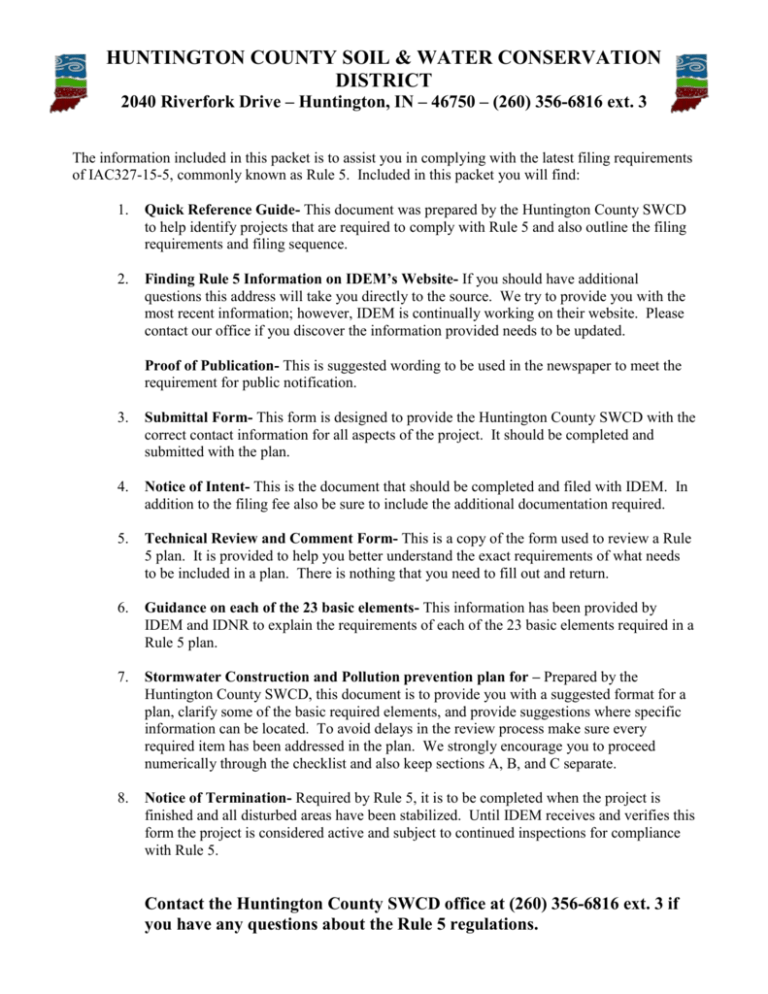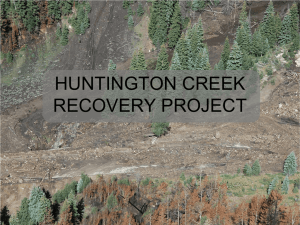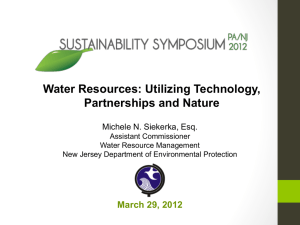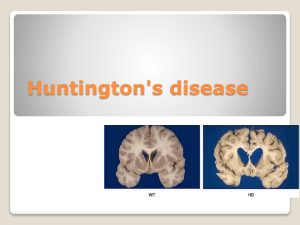HUNTINGTON COUNTY SOIL & WATER CONSERVATION DISTRICT
advertisement

HUNTINGTON COUNTY SOIL & WATER CONSERVATION DISTRICT 2040 Riverfork Drive – Huntington, IN – 46750 – (260) 356-6816 ext. 3 The information included in this packet is to assist you in complying with the latest filing requirements of IAC327-15-5, commonly known as Rule 5. Included in this packet you will find: 1. Quick Reference Guide- This document was prepared by the Huntington County SWCD to help identify projects that are required to comply with Rule 5 and also outline the filing requirements and filing sequence. 2. Finding Rule 5 Information on IDEM’s Website- If you should have additional questions this address will take you directly to the source. We try to provide you with the most recent information; however, IDEM is continually working on their website. Please contact our office if you discover the information provided needs to be updated. Proof of Publication- This is suggested wording to be used in the newspaper to meet the requirement for public notification. 3. Submittal Form- This form is designed to provide the Huntington County SWCD with the correct contact information for all aspects of the project. It should be completed and submitted with the plan. 4. Notice of Intent- This is the document that should be completed and filed with IDEM. In addition to the filing fee also be sure to include the additional documentation required. 5. Technical Review and Comment Form- This is a copy of the form used to review a Rule 5 plan. It is provided to help you better understand the exact requirements of what needs to be included in a plan. There is nothing that you need to fill out and return. 6. Guidance on each of the 23 basic elements- This information has been provided by IDEM and IDNR to explain the requirements of each of the 23 basic elements required in a Rule 5 plan. 7. Stormwater Construction and Pollution prevention plan for – Prepared by the Huntington County SWCD, this document is to provide you with a suggested format for a plan, clarify some of the basic required elements, and provide suggestions where specific information can be located. To avoid delays in the review process make sure every required item has been addressed in the plan. We strongly encourage you to proceed numerically through the checklist and also keep sections A, B, and C separate. 8. Notice of Termination- Required by Rule 5, it is to be completed when the project is finished and all disturbed areas have been stabilized. Until IDEM receives and verifies this form the project is considered active and subject to continued inspections for compliance with Rule 5. Contact the Huntington County SWCD office at (260) 356-6816 ext. 3 if you have any questions about the Rule 5 regulations. Quick Reference Guide: Compliance Requirements for Rule 5 Projects that are required to comply: Any construction activity, which includes clearing, grading, excavation, and other land disturbing activities that results in the disturbance of one(1) or more acres of total land area. * Total Land Area includes any earth disturbing activity over the life of the project and also includes activities that are required to provide services to the project when they are under the control of the project site owner. For example: sanitary sewer, storm sewer, or water lines. If a project is less than one (1) acre but part of a larger development plan, individual filing is not required. However, the project is required to comply with the erosion and sediment control plan set forth for the larger development plan. If a project is more than one acre and part of a larger development plan, the project must file as an individual project. See filing requirements. For Multi-lot projects, the area of land disturbance shall be calculated by adding the total area of land disturbance for improvements, including streets, roads, utilities, and common areas in addition to the expected total disturbance on each individual lot , as determined by the following: 1. Single-family residential project where the lots are one-half acre or more use one-half acre. 2. Single-family residential project where the lots are less than one-half acre use the acreage of the entire lot. 3. On all other types of projects, such as industrial and commercial, a minimum of one acre of disturbance must be used, unless the lots are less than one acre, then the entire acreage of each lot should be used. Exempt projects: 1. Single family residential dwellings disturbing less than five (5) acres, where they are not part of a larger common plan of development. Earth disturbing activities for this exemption includes the dwelling, driveway, and septic system only. 2. Agriculture land disturbing activities such as planting, disking, installation of agriculture conservation practices, and tile installation. See definitions in attached rule. Ponds are not considered an agricultural land disturbing activity or an agriculture conservation practice. 3. Forest harvesting activities 4. Coal mining activities permitted under IC 14-34 5. Landfills, closed and active, permitted under 329 IAC10 Questions or comments: Contact the Huntington County Soil and Water Conservation District Office at (260) 356-6816 ext. 3. Filing Requirements for Rule 5 (Steps 1-3 to be completed a minimum of 30 days prior to land disturbing activities. More time may be required if the plan is not approved on first review) 1. Develop an Erosion and Sediment Control Plan Develop an Erosion and Sediment Control Plan in accordance with the requirements listed under IAC 15-5-6.5, IAC 15-5-7, and IAC 15-5-7.5. 2. Submit Plan to Huntington County SWCD For Review Deliver a copy of the Erosion and Sediment Control Plan to the Huntington County Soil and Water Conservation District (SWCD) for review. The Huntington County SWCD will have 28 days to review the plan for compliance with the rule. (Note: If 28 days have passed from the date the Huntington County SWCD has received the plan and you have not received word that the plan is approved or deficient, proceed with filing the Notice of Intent with IDEM). While not required, it would also be to your benefit to include a draft copy of the completed Notice of Intent (NOI) form for review along with the plan. 3. Public Notification Public Notification must be done in a newspaper of general circulation in the affected area to notify the public that construction activity under this rule is to commence. Suggested verbiage is exhibited in IAC 327 15-5-5, a, 9. A copy of the notice will be needed to accompany the NOI sent to the Indiana Department of Environmental Management (IDEM). PLEASE NOTE: Step 4 to be completed after steps 1-3 and a minimum of 48 hours prior to land disturbing activity. 4. File Notice of Intent and Supporting Documentation with IDEM A Notice of Intent (NOI) form complete, signed, and dated along with supporting documentation must be filed with IDEM a minimum of 48 hours prior to land disturbing activities. A copy of this information also needs to be filed with the Huntington County SWCD. Notice of Intent forms are available on the IDEM website or at the Huntington County SWCD office. Supporting documentation includes the following: 1. Proof of Publication: a copy of the Public Notification as it appeared in the newspaper. 2. Notice of an Approved Plan: a copy of the Notice of an Approved plan that you receive from the Huntington County SWCD. Send all information to : Indiana Department of Environmental Management Attention OWQ Rule 5 Cashiers Office 100 North Senate Avenue MC 50-10C Indianapolis, IN 46204 Questions or Comments: Contact the Huntington County Soil and Water Conservation District Office at (260) 356-6816 ext. 3 Finding Rule 5 Information on the IDEM Website As of November 22, 2010 Go to www.in.gov/idem In menu on left under “Environmental Information”, select Permitting, then click on Water Permits, this will take you to the page with information for Rule 5,6 and 13. You can access step by step compliance information and forms for each of the “Storm Water” regulation programs. _________________________________________ Notice of Intent Requirements: Proof of Publication Proof of publication should appear in a newspaper of general circulation in the affected area that notifies the public that construction activity is to commence, that states: “(Company name, address) is submitting an NOI letter to notify the Indiana Department of Environmental Management of our intent to comply with the requirements under 327 IAC 15-5 to discharge storm water from construction activities for the following project: (name of the construction project, address of the location of the construction project). Run-off from the project site will discharge to (stream(s) receiving the discharge(s)).” Please note, the company name and address should be the project owner or developer; the person or firm that has final approval for the project. Stormwater Construction and Pollution Prevention Plan for: A1- Index: Construction Plan Elements………………………………………….Page_______ (Items listed in chronological order A1-A23) Stormwater Pollution Prevention- Construction……………………..Page_______ (Items listed in chronological order B1- B15) Stormwater Pollution Prevention- Post Construction………………..Page_______ (Items listed in chronological order C1- C5) A2- Include a Sketch of the Project to show the proposed project in relation to adjacent land uses and structures. Similar to what is required by planning commission. Please use 8 ½ x 11 or 11x17 size paper only. A3- Narrative describing project nature and purpose: Briefly describe the project and why or what purpose it will serve. Example: The project will include an approximate 1.5 acre pond and all earth disturbing activities associated with construction. It is intended to be used for recreational purposes by the landowners. A4- Vicinity map showing the project location: A copy of the plat map with the project location highlighted will be adequate for this requirement. The Huntington County SWCD can assist you with this information. A5- Legal Description of the Project Site: This information can be found on the legal documents or survey received when the project was purchased. A6- Location of all lots and proposed site improvements: You can reference the sketch in A2 as long as it show such things as the dam that may be constructed, outlet of the pond, emergency spillway for the pond, any borrow or stock pile areas associated with construction of the pond. Also include location of such things as the beach, pier, or any dry hydrants that may be installed. A7- Hydrologic Unit Code: This information can be provided by the Huntington County SWCD. A8- Notation of any State or Federal Water Quality Permits: This would be any permit required by IDNR, IDEM, or Army Corps of Engineers, etc. If no permits are required this needs to be stated in the plan. The Huntington County Plan Commission or Huntington County SWCD can assist you with this information. A9- Specific points where stormwater discharge will leave the site: You may reference the sketch in A2 and the discharge points of the primary and emergency outlets of the pond. A10- Location and name of all wetlands, lakes, and water courses on and adjacent to the site: You may reference the sketch for A2 and show the location of any of these items. It would Also be good to list the name of any legal names for the above items. A11- Identify All Receiving Waters: List where the water will run to after it leaves the site. Example: Through a private field tile drainage system that discharges into Silver Creek. A12- Identification on potential discharges into groundwater: List anyway that discharges could be discharged into groundwater supplies. The most notable examples of these would be abandoned wells, or sinkholes. If the requirement does not apply to this project location a simple statement indicating this should be included in the plan. A13- 100 Year Floodplains, floodways, and floodway fringes: If the project is not located in any of these areas a simple statement indicating this should be included in the plan. If the project does lie in one of these areas under what conditions is construction being allowed in this area? This information is available from the Plan Commission office, Huntington County Surveyor’s Office, or Huntington County SWCD. A14- Pre-construction and post construction estimate of Peak Discharge: This information is available from the Huntington County SWCD office. A15- Adjacent landuse, including upstream watershed: Describe the land use of surrounding areas. Example: Woodland, Ag land, Residential housing. A16- Locations and approximate boundaries of all disturbed areas: You may reference the sketch provided for requirement A2. A17- Identification of existing vegetative cover: Simply state what is growing/covering the site prior to construction activity. Example: Sod, Crop stubble, etc. A18- Soils map including descriptions and limitations: This information is located in the soil survey for Huntington County. The Huntington County SWCD can assist you with this information. A19- Locations, size and dimensions of proposed stormwater systems: For ponds, this would be referring to the primary and emergency outlets of the pond. You may reference the sketch for A2 for the location of these items and also include a brief description of size and design futures. A20- Plan for any off-site construction activities associated with this project: This is generally referring to utility work that a project would require such as sewer, water, or other utilities. If it is not applicable at this project site a statement indicating this should be included in the plan. A21- Locations of proposed soil stockpiles, borrow and/or disposal areas: If applicable, locations for these practices may be shown on the sketch required for A2 and referenced. If it is not applicable at this project site a statement indicating this should be included in the plan. A22- Existing site topography at an interval appropriate to show detailed drainage patterns: The Huntington County SWCD has topography maps that may be copied and highlighted to meet this requirement for smaller projects. You can also access this information at www.topozone.com A23- Proposed final topography at an interval appropriate to show detailed drainage patterns: This requirement may be combined with the map for A22. Show the location of the proposed project on the map. Describe in a brief narrative the changes in the topography and indicate the direction of water flow after construction activity has ended. You can also access this information at www.topozone.com and add some directional arrows as to how water will flow post construction. Section B B1- Description of potential pollutant sources associated with construction activities: A list of potential pollutant sources such as material and fuel storage areas, fueling locations, exposed soils, leaking vehicles and equipment, etc. (This item is not required for single-family residential developments of 4 lots or less and single-family residential strip developments) B2- Sequence describing stormwater quality measure implementation relative to land disturbing activities: Each plan should contain multiple stormwater pollution prevention measures. Various measures will be installed at different times throughout the construction process. Each proposed measure should be identified in the sequence as to when it is to be installed in relation to land disturbing activities. B3- Stable construction entrance locations and specifications: If you are able to show this on the sketch for A2 do so and reference it for this requirement. If not, or you will be using an existing location briefly state this in narrative form. B4- Sediment control measures for sheet flow areas: This item is intended to evaluate the areas of the site where runoff will be primarily in a sheet flow condition. If it is not applicable at this project site a statement indicating this should be included in the plan. B5- Sediment control measures for concentrated flow areas: This item is intended to evaluate the areas of the site where runoff will be primarily in a concentrated flow condition. In a pond application this would be the areas at the end of the primary and emergency outlets. B6- Storm sewer inlet protection measure locations and specifications: If surface inlets, including curb inlets, are present, the plan should include protection measures to prevent sediment from entering the storm drain system. It is highly unlikely that this would be applicable in pond construction. Note: If there are any surface inlets for drainage tile then this would apply. B7- Runoff control measures: This item refers to measures such as diversions, rock check dams, slope drains, etc. These types of measures may not be necessary on every project. If plan reviewer feels that they are necessary the plan should be evaluated as to whether the issue was adequately addressed in the plan. B8- Stormwater outlet protection specifications: All stormwater discharge locations need to be adequately protected to prevent scour erosion. This is similar to requirement B5 in pond construction. Reference B5. B9- Grade Stabilization structure locations and specifications: This item refers to measures such as rock chutes, toe wall and drop structures, etc. These types of measures may not be necessary on every project. If plan reviewer feels that they are necessary the plan should be evaluated as to whether the issue was adequately addressed in the plan. B10- Location, dimensions, specifications, and construction details of each stormwater quality measure: Each proposed measure should be clearly located in the plan. Some plans may not provide the location in a pictorial format on the plan drawings, but may provide clear text or a table to depict where various practices should be located. B11- Temporary surface stabilization methods appropriate for each season: There should be multiple methods, as the various seasons need to be considered. If project is expected to be short lived, these seasonal options must be supplied. B12- Permanent surface stabilization specifications: The permanent stabilization methods should be clearly specified with sequencing information included. B13- Material handling and spill prevention plan: Include a brief statement that it is the contractor’s responsibility that measures will be taken to prevent any spills from occurring and a list of materials being used. If a spill occurs the local Haz-Mat Team will be contacted and include in the plan the phone number for Haz- Mat. (This item is not required for single-family residential developments of 4 lots or less and single-family residential strip developments) B14- Monitoring and maintenance guidelines for each proposed pollution prevention measure: The maintenance guidelines for the project should also include instructions on how the monitoring and maintenance procedures are to be carried out. Each proposed measure must be accompanied by instructions for evaluating the practice for maintenance needs once installed. B15- Erosion and Sediment control specifications for individual building lots: This requirement can be met by including a copy of “Erosion and Sediment Control for Individual Building lots” available on the IDNR-Division Of Soil Conservation website. In a pond application this would not be required. A statement indicating this should be included in the plan. Section C C1- Description of pollutants and their sources associated with the proposed land use: The plan should include a list of expected pollutant sources from the proposed land use, which may add a significant amount of pollutants to stormwater discharges. Examples: oil, grease, gasoline, sediment, and biological agents from trash. C2- Sequence describing stormwater quality measure implementation: Provide a sequence of when the proposed post construction stormwater measures will be installed. Basins and ponds could be utilized during construction for sediment control. C3- Description of pollutants and their sources associated with the proposed land use: The plan should include a narrative description that discussed how the project was designed to minimize the generation of post construction pollutants, and how the proposed post construction stormwater quality measures will improve the quality of the stormwater discharge from the finished project. C4- Location, dimensions, specifications and construction details of each stormwater quality measure: All proposed post construction stormwater quality measures should be clearly shown on the plan, and include specifications and construction details similar to those that have been required for erosion sediment control measures during construction. C5- Description of maintenance guidelines for proposed post construction water quality measures: A narrative description of the maintenance guidelines for all post construction stormwater quality measures to facilitate their proper long term function should be included. The plan should identify the parties or individuals that will be responsible for the future long-term maintenance. Description of the entity should be sufficient.







